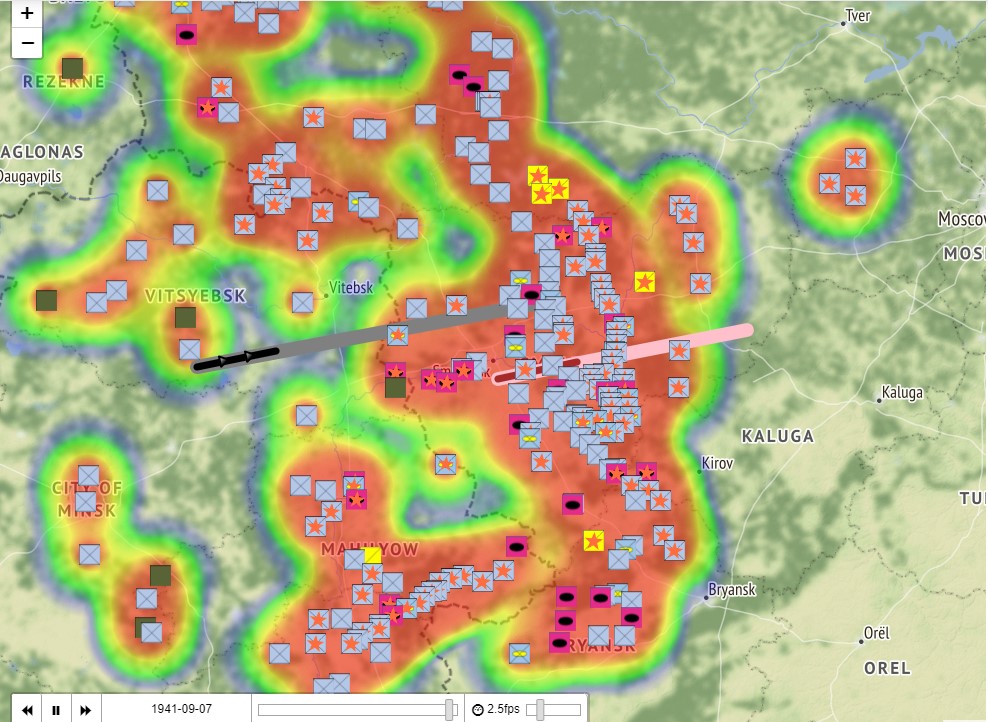
Battle Flow

Two FORCES faculty leaders, Dr. Jonathan Poggie and Sorin Adam Matei, have created BattleFlow a new continuous-flow method of simulating military operations. The BattleFlow method, inspired by fluid mechanics, treats military units as force projection entities. Force is considered a density-distribution surface. The surface has a defined shape and dimensions, indicating the presence and ability of the unit to execute military offensive and defensive military operations. Unlike discrete agent models, BattleFlow does not need to keep track of discrete members of a unit (soldiers or subunits), estimating them on the go as a continuous density distribution. Traditional discrete agent models typically infer global behaviors from local actions and characteristics. Our model starts with a global view while estimating local processes, as well. This allows a much clearer and realistic estimation of the process that is simulated, while dramatically reducing computational requirements.
The method can simulate any military conflict between military units of a defined size and force. The model predicts where all units will go, both as individual units but also as members of greater units (e.g., regiments, brigades, divisions, squadrons, groups, task forces, etc). The model estimates how much offensive or defensive power the units will use and with what effect on the opposing force, while considering physical (terrestrial, maritime, or air) obstacles or adverse phenomena. Furthermore, the model depletes the opposing forces proportional to their force projection abilities. The model applies to all combatants engaged in an operation, equally, regardless of side.
The distinguishing feature of the BattleFlow model is that it estimates continuous and simultaneous movement and losses of all sides involved in a specific military operation. Furthermore, the model estimates for contiguous units their shape and density, their breaking points, and the most likely direction of dispersion or withdrawal. This can be applied to any type of unit, from infantry to mechanized, naval, or air units moving and attacking or defending as one.
Currently, the model is tested on historical terrestrial operations, including older (Gettysburg) and more recent (Omaha Beach, Operation Barbarossa, Battle of 73 Easting) battles or operations. However, we are working on a joint naval-air operation simulation, that assumes complex units (aircraft carrier groups, submarine units, autonomous attack fighters, and hypersonic weapons) in the context of a blockade-running scenario. This model intersects with our other line of research, which estimates geographic conflict flashpoints in South East Asia.
The model can be used for assessing the viability of various tactical and operational scenarios, probable losses, and potential weak or strong points in the enemy and one’s own asset dispositions.
The computational model was developed by a team of physicists, engineers, social scientists, and historians. The visualization of the simulation can be presented in 2D and 3D (VR) environments.
The simulation model has been published in peer-reviewed papers and a patent is pending.
Useful links
A description of the overall BattleFlow model illustrated by the Gettysburg Simulation
The peer-reviewed paper that presents the technical details (A powerpoint presentation of the core model characteristics can be requested via email from forces at Purdue dot edu)
A visualization of Pickett's charge at the Gettysburg battle
A visualization of the Omaha Beach simulation
The project is the product of a close collaboration between FORCES Founder Sorin Adam Matei, PhD, an expert in spatial social statistics, Dr. Jonathan Poggie, a physicist and engineering who specializes in complex computational modeling, Lt Col (r) Robert Kirchubel, PhD a widely published author of World War II operational military histories , and several cohorts of graduate and undergraduate students.
To learn more about our project, contact us at forces at Purdue dot edu
Video of an OPMAP animated maps: the battle of Somlensk, July-August 1941.